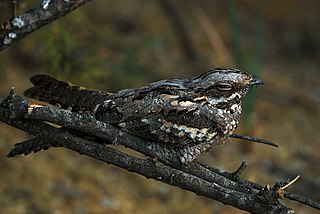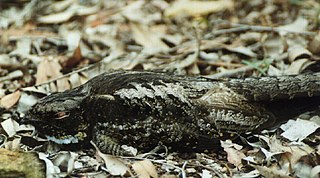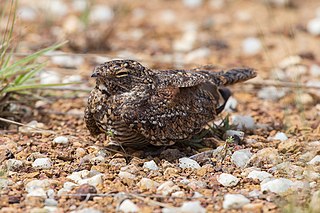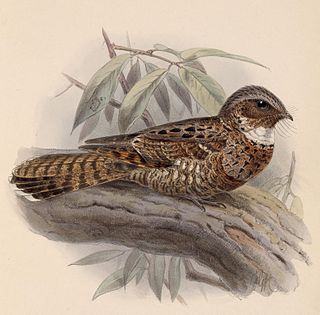
The European nightjar, common goatsucker, Eurasian nightjar or just nightjar, is a crepuscular and nocturnal bird in the nightjar family that breeds across most of Europe and the Palearctic to Mongolia and Northwestern China. The Latin generic name refers to the old myth that the nocturnal nightjar suckled from goats, causing them to cease to give milk. The six subspecies differ clinally, the birds becoming smaller and paler towards the east of the range. All populations are migratory, wintering in sub-Saharan Africa. Their densely patterned grey and brown plumage makes individuals difficult to see in the daytime when they rest on the ground or perch motionless along a branch, although the male shows white patches in the wings and tail as he flies at night.

The common nighthawk or bullbat is a medium-sized crepuscular or nocturnal bird of the Americas within the nightjar (Caprimulgidae) family, whose presence and identity are best revealed by its vocalization. Typically dark, displaying cryptic colouration and intricate patterns, this bird is difficult to spot with the naked eye during the day. This bird is most conspicuous when in its buoyant and erratic flight. The most remarkable feature of this aerial insectivore is its small beak that belies the massiveness of its mouth. Some claim appearance similarities to owls. With its horizontal stance and short legs, the common nighthawk does not travel frequently on the ground, instead preferring to perch horizontally, parallel to branches, on posts, on the ground or on a roof. The males of this species may roost together but the bird is primarily solitary. The common nighthawk shows variability in territory size.

The Puerto Rican nightjar or Puerto Rican whip-poor-will is a bird in the nightjar family found in the coastal dry scrub forests in localized areas of southwestern Puerto Rico. It was described in 1916 from bones found in a cave in north central Puerto Rico and a single skin specimen from 1888, and was considered extinct until observed in the wild in 1961. The current population is estimated as 1,400-2,000 mature birds. The species is currently classified as Endangered due to pressures from habitat loss.

The lesser nighthawk is a nightjar found throughout a large part of the Americas. This bird looks similar to the common nighthawk but is slightly smaller, has a slightly less deeply forked tail, and is more buffy in coloration. Their distinctive mouths are very well adapted for capturing insects mid-flight.

The eared nightjars are a small group of nocturnal birds in the nightjar family, although the taxonomy is uncertain. There are seven species, mainly found in forest and scrub from China to Australia. Five species are placed in the genus, Eurostopodus, the other two species in Lyncornis. They are long winged birds with plumage patterned with grey and brown to camouflage them when resting on the ground. They feed on insects caught in flight. A single white egg is laid directly on the ground and incubated by both adults. The chicks can walk soon after hatching.

The Philippine frogmouth is a nocturnal bird that can be found throughout the Philippine archipelago. It is common in lowland forests and maturing second growth. There is little information about the bird. It feeds on grasshoppers, cicadas, crickets and beetles.

The pygmy nightjar is a species of nightjar in the family Caprimulgidae. It is endemic to Brazil.

The band-winged nightjar or greater band-winged nightjar is a species of nightjar in the family Caprimulgidae. It is widespread in South America, where it is found in the Andes, Venezuelan Coastal Range, Santa Marta Mountains, Tepuis, most of Chile, Argentina, Paraguay, Uruguay, and eastern Brazil. It occurs in a wide range of habitats, from the edge of humid montane forests to shrubby semi-deserts and urban rooftops.

The fiery-necked nightjar is a species of nightjar in the family Caprimulgidae, which is found mostly in Africa south of the equator, though it has been spotted in a few countries north of the equator. It is most often found in woodland savannas or other deciduous woodlands. It is usually distinguished by its tawny coloured collar which gives the species its common name. It has a distinctive call that many have rendered as 'good-lord-deliver-us'. The fiery-necked nightjar is an insectivorous species that mostly eats butterflies, moths and other insects. The fiery-necked nightjar breeds after the dry season and typically produce two clutches with two eggs per clutch.

The rufous-cheeked nightjar is a species of nightjar in the family Caprimulgidae. It is an intra-African migrant that breeds in the south of its range. It spends the non-breeding season in eastern Nigeria, Cameroon, southern Chad and Sudan, the Republic of the Congo, the D.R.C. and western Central African Republic. Throughout the year it can be found in Southern Africa. It is a nocturnal species that feeds on flying insects, mainly hunting at dusk and the early night. They can hunt at night thanks to their large eyes that are adept at seeing in the dark. They cannot see in complete darkness and most likely cannot see colours either. The rufous-cheeked nightjar forms monogamous pairs and the egg laying period is from September to November. It looks very similar to other African nightjars and they are frequently misidentified during research and studies.

The freckled nightjar or freckled rock nightjar is a species of nightjar in the family Caprimulgidae. It has a wide yet patchy distribution throughout the Afrotropics.

The least nighthawk is a species of nightjar in the family Caprimulgidae. It is found in Argentina, Bolivia, Brazil, Colombia, Guyana, Suriname, and Venezuela.

The sand-colored nighthawk is a species of nightjar in the family Caprimulgidae. It is found in Bolivia, Brazil, Colombia, Ecuador, Peru, and Venezuela.

The white-winged nightjar is a species of nightjar in the family Caprimulgidae. It is found in Bolivia, Brazil and Paraguay.

The spotted nightjar or spotted eared-nightjar is a species of nightjar in the family Caprimulgidae. It inhabits much of mainland Australia and has also been found in several Indonesian islands. Its natural habitats are open forests and woodlands, scrub, spinifex and tussock grassland, savannah woodland and mangroves.

The great eared nightjar is a species of nightjar in the family Caprimulgidae. It is found in southwest India and in parts of Southeast Asia. This very large nightjar has long barred wings, a barred tail and long ear-tufts which are often recumbent. It has a white throat band but has no white on its wings or on its tail.

The white-throated nightjar or white-throated eared-nightjar is a species of nightjar in the family Caprimulgidae. It is endemic to eastern Australia; it is a non-breeding winter visitor in Papua New Guinea. Its natural habitat is subtropical or tropical dry forests.

The ladder-tailed nightjar is a species of bird in the family Caprimulgidae, the nightjars. It is one of two species in the genus, Hydropsalis.

The Yucatan poorwill is a species of nightjar in the family Caprimulgidae. It is found in the Yucatán Peninsula of Belize, Guatemala, and Mexico.

The band-tailed nighthawk is a species of nightjar in the family Caprimulgidae. It is found in Bolivia, Brazil, Colombia, Ecuador, French Guiana, Guyana, Paraguay, Peru, and Venezuela. Its natural habitats are subtropical or tropical moist lowland forest, rivers, and swamps. They are most vocal during the night time, indicating that they are nocturnal birds. When they sing it has a very similar pitch to a frog's ribbit. This is most common during breeding season, which occurs from July until October. Band-tailed nighthawks have an interesting reproductive strategy. Instead of building traditional nests, they lay their eggs directly on the ground, typically in concealed locations within their forested habitats. This adaptation may help reduce the chances of nest predation.






















